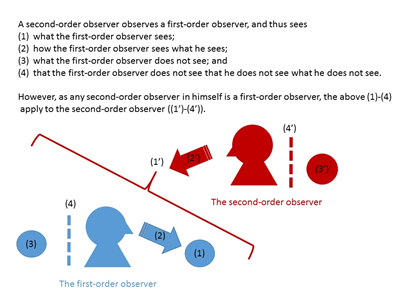Self-observation
!!! De schuingedrukte tekst hieronder bevat veel speciale tekens die we zelf moeten gaan toevoegen (zie PDF met dezelfde tekst als hieronder):
A second-order observer observing himself as a first-order observer leads to a paradox. As a second-order observer, you see both sides of the distinction, including your own blind spot, which is then no blind spot anymore. Again, this paradox is, as usual by now, de-paradoxified in time. First of all, every observer does have a blind spot regardless whether a first-order or second-order observer position is taken. In the very act of observing, you see only one side of a distinction. What you see as a second-observer observing yourself is what you once was in relation to the world.
The distinction is re-entered in its own identical space. But the re-entered mark of distinction has become a mark that cannot be crossed anymore. The past is the past, and there is nothing you can do about it. The distinction is taken as an indivisible whole indicating your actions and the resulting reactions of the world in the past.
Statement: Concentrate on how to look, instead of what to see.
Aspect: Critical Reflection, Principle: Create room for change, Principle page: Principles and Ground Rules
| Statement page | Statement |
|---|---|
| Determining Boundary Judgements with CSH | A constructive dialog can take place on the basis of first and second order boundary judgments. |
| Self-observation | Concentrate on how to look, instead of what to see. |
| Self-observation | You need someone else to point out your blind spots to you. |
Principles, aspects and statements overview
- Create room for change, defined in page: Principles and Ground Rules
- Systems Thinking, defined in page: Principles and Ground Rules
- Hard Systems Thinking – System Dynamics (A system comprised of a number of interacting feedback loops is a complex system whose behavior can surprise us.)
- Systems Thinking (A system as a whole is comprised of parts. Systems thinking is about understanding the interactions between the parts.)
- Critical Reflection, defined in page: Principles and Ground Rules
- Determining Boundary Judgements with CSH (A constructive dialog can take place on the basis of first and second order boundary judgments.)
- Self-observation (Concentrate on how to look, instead of what to see.)
- Self-observation (You need someone else to point out your blind spots to you.)
- Diversity in opinions, defined in page: Principles and Ground Rules
- Worldview, defined in page: Principles and Ground Rules
- Model Building - Human Activity Systems (A worldview (Weltanschauung) captures the beliefs, desires and intentions of a person.)
- Model Building - Human Activity Systems (The PQR formula (what, how, why) is pivotal for capturing worldviews.)
- Soft Systems Thinking – Soft Systems Methodology (People differ in worldviews, but nevertheless they typically adhere to aspects of multiple worldviews, which provides room for accommodation.)
- We got to move, defined in page: Principles and Ground Rules
- Reflexive Domain, defined in page: Principles and Ground Rules
- Exploring Change (The constant factor in life is movement.)
- Self-Reference in a Three-Valued System (Embrace the paradox, i.e., a difference in what was previously stated and therefore contradicting what was said before. Differences keep setting things in motion. Without differences we cease to exist. Therefore, change is inevitable, in fact, it is a necessity for living.)
- The Autopoietic Turn (Humans and social systems operate autonomously and my react when irritated.)
- Tradition, defined in page: Principles and Ground Rules
- Exploring Change (A system has to become what it is not, and yet remain the same.)
- Some-thing from No-thing (The relationship between things, including humans, is what matters. Something or someone cannot stand or be taken on its own.)
- Determine the right direction, defined in page: Principles and Ground Rules
- Cultural Identity, defined in page: Principles and Ground Rules
- Investigating Identity (Group identity refers to a person’s sense of belonging to a particular group.)
- Research Philosophy and Process (Research approach must be “for you, and with you”, instead of “for you, but not with you”.)
- Right Things, defined in page: Principles and Ground Rules
- Co-dependency, defined in page: Principles and Ground Rules
- Ethics of Care, defined in page: Principles and Ground Rules
- Investigating Identity (Ethics of Care is a retreat to first principles to be part of a group to protect and to provide meaning.)
- Responsible Setting for Social Innovation (Each stakeholder facilitates other stakeholders in addressing a societal challenge.)
- Some-thing from No-thing (We rely on each other and therefore we should care for each other.)
Incidentally, by conceptualizing self-reflection as a second-order observation observing yourself, it becomes clear that history does matter. Things done in the past shape present and future actions. As Gadamer argues, we cannot escape tradition (cite{Truth and Methods}). Tradition is overarching, which also holds for applying the scientific method in human sciences. To put it bluntly, the scientific method objectifies the present but without taking into consideration what we used to do and why, that is, our tradition. But tradition cannot be brushed away from human life, and that, ironically, applies for the way we conduct scientific research as well because the scientific method itself evolves in time due to new insights. Thus tradition is overarching, but it also evolves.
- Lees hiervoor:
- Lees hierna:
Referenties
- Truth and Method (Wahrheit und Methode), Hans-Georg Gadamer, 1 januari 1960.

